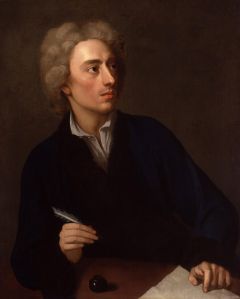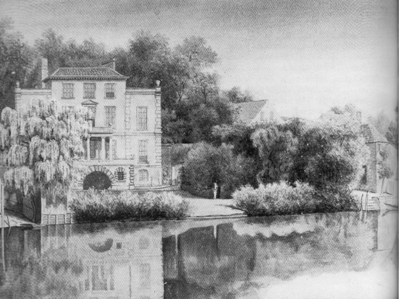
Alexander Pope (1688-1744) turned 40 on 21 May 1728, just four days after the first part of his mock epic The Dunciad was published. For all its technical brilliance and customary multitude of levels at which it can be read, the poem was the latest salvo in a longstanding feud, partly in response to attacks on Pope’s 1725 edition of the complete works of Shakespeare (the second edition of which was published in 1728 also).
Lewis Theobald, who also edited Shakespeare in the Eighteenth Century, had been critical of Pope’s edition in a review, for which he wound up as the hero ‘Tibbald’ of Pope’s Dunciad. Pope published the first part of this poem anonymously in May 1728, though it was widely recognised as Pope’s work. It followed another work published the year before, to which Pope had put his name, The Art of Sinking in Poetry, in which he once again attacked his critics and rival poets. In The Dunciad he widens his attack to take in the whole of society, with his description of a kingdom of dullness, led by Dunce I (George I) and Dunce II (George II).
 If Pope thought he had been under attack before, the publication of The Dunciad only exacerbated the situation, to which Pope in turn responded with further volumes of the poem appearing in 1729, 1742 and 1743. Such was the level of scorn put upon him by his detractors for this scandalous work that he was said to only leave the house and walk in public if accompanied by his great dane and with two pistols on his person. For in addition to being a response to personal attacks, it was also part of a wider campaign to attack the Whig government, led by the unpopular Walpole, whom Pope himself had been in close contacts with. In attacking the government he was aided by fellow members of the Scriblerus Club – a collection of wits seeking to mock high writing, and the Whigs in the process, and including among their number the three Johns: John Gay, Jonathan Swift and John Arbuthnot. Together they showed the power of the pen as a political tool, writing pointed satires to highlight the folly of those in charge.
If Pope thought he had been under attack before, the publication of The Dunciad only exacerbated the situation, to which Pope in turn responded with further volumes of the poem appearing in 1729, 1742 and 1743. Such was the level of scorn put upon him by his detractors for this scandalous work that he was said to only leave the house and walk in public if accompanied by his great dane and with two pistols on his person. For in addition to being a response to personal attacks, it was also part of a wider campaign to attack the Whig government, led by the unpopular Walpole, whom Pope himself had been in close contacts with. In attacking the government he was aided by fellow members of the Scriblerus Club – a collection of wits seeking to mock high writing, and the Whigs in the process, and including among their number the three Johns: John Gay, Jonathan Swift and John Arbuthnot. Together they showed the power of the pen as a political tool, writing pointed satires to highlight the folly of those in charge.

The impression one gets of Pope from all of the above is of a writer highly political, devious, and with an axe to grind, but neither was he short of friends. He never married, and at age 40 was living in Twickenham with his widowed mother Edith. Pope himself suffered from ill health, developing what may have been tuberculosis (an exact diagnosis has not been agreed upon by scholars) which caused a curvature of his spine – something Pope himself put down to too much study. Thus behind the fiery satirist lay a vulnerable, caring character. At 40 years old he had already achieved a great deal – in addition to his edition of Shakespeare, he had also translated Homer’s Iliad and Odyssey, not to mention his own masterpiece The Rape of the Lock. But nor was he slowing down either, with a great many more works still to come before his death aged 66. For Pope, 40 was right in the middle of his stride.
Pope and Buckingham: Pope is a key figure in the Restoration and Augustan Literature module, with his mock-epic poem The Rape of the Lock being a set text.
